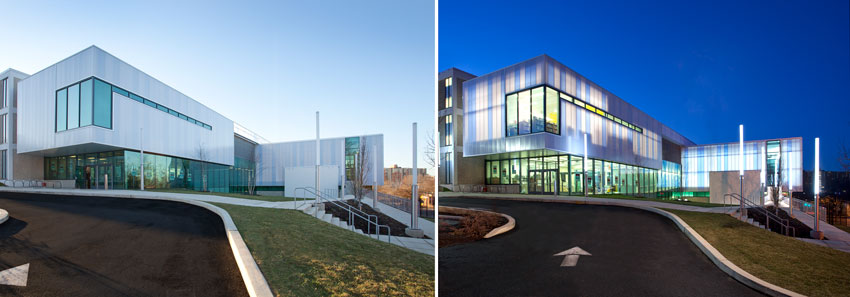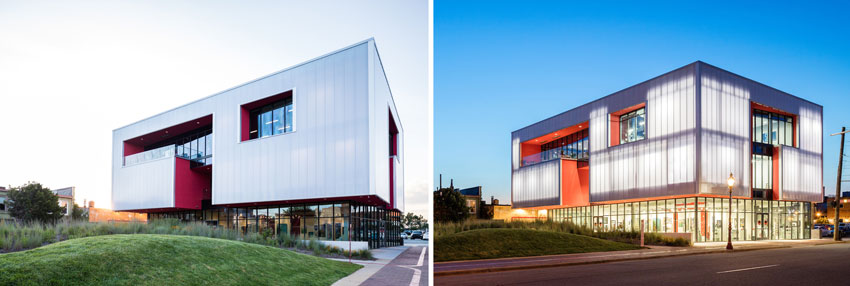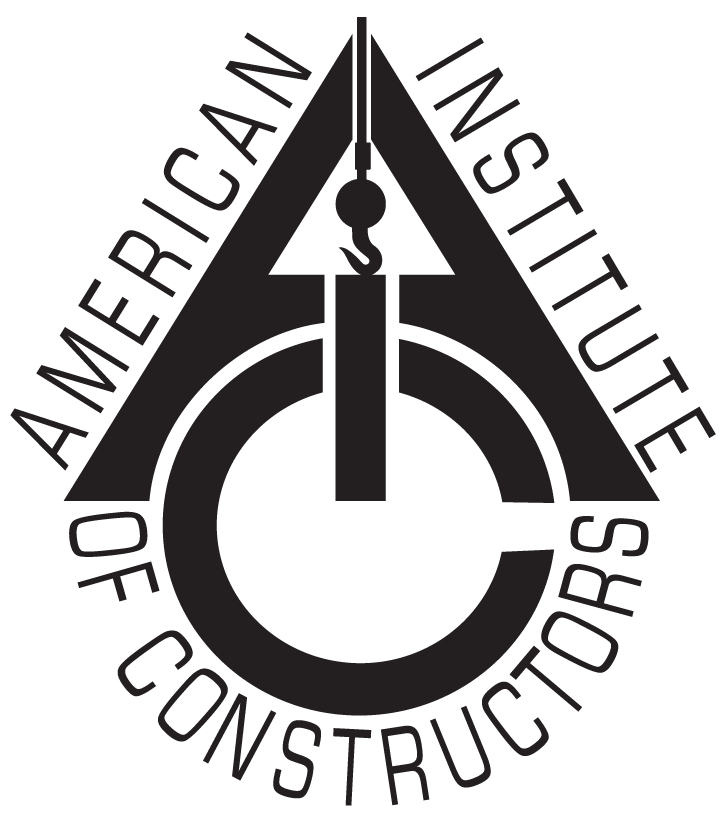This CE Center article is no longer eligible for receiving credits.
One of the hallmarks of a green building is the use of natural daylight to create a positive quality of lighting for indoor environments. This feature, when coupled with appropriate electric light switches or controls, also has the added benefit of being able to reduce energy costs for artificial lighting. When electric lights are turned off, they don’t generate heat, so less cooling is needed in a building. Hence, daylighting provides multiple benefits for people and buildings, but how is it best accomplished? New advances in building product technology now make it possible for architects to consider not only window openings for daylighting but the creation of entire daylit building facades. Further, understanding that clear-view glazing is not necessarily the first choice for good quality daylighting, investigation into other options using translucent glazing is warranted. Such translucent systems offer better glare control, higher thermal performance, and easier maintenance compared to clear glass systems. This course will explore some of these systems and the ways that they can contribute to innovatively designed, high-performing buildings that are fully code compliant, green, and sustainable.
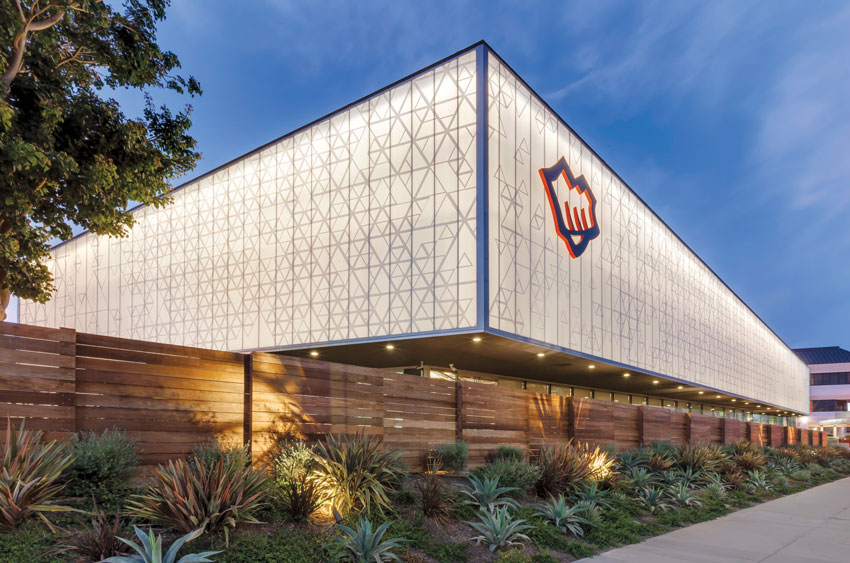
© RMA Photography Inc.
Project: Element LA
Location: Los Angeles
Architect: Gensler
High-performance daylighting facades are possible using advanced systems that combine glare-controlled translucent light with customizable, thermally efficient, two-panel polycarbonate systems and nighttime facade illumination, as shown here.
Daylighting Evolution
Incorporating natural light into buildings has been part of design and construction since primitive times and has continued throughout all historical time eras in all parts of the world. So why is it seen as something new or different today? Because our building envelopes are different than in historical times.
We no longer rely solely on the heavy mass of cave dwellings or masonry buildings to separate the indoors from the outdoors. Rather, we more commonly use lighter-weight structural systems that are clad with lightweight building envelopes that need to provide a series of functions, only one of which is to allow natural daylight. And, just as importantly, that daylight needs to be controlled so that it is useful, without creating glare or other unwanted outcomes for occupants. At the same time, 21st century building enclosures need to meet significant standards for energy conservation in buildings, whether for minimum energy code compliance or to achieve high performance as demonstrated through voluntary certification programs such as LEED.
A frequently referenced resource, particularly for government or institutional buildings, is the Whole Building Design Guide. It discusses and defines daylighting for buildings of our era this way: “Daylighting is the controlled admission of natural light, direct sunlight, and diffused skylight into a building to reduce electric lighting and saving energy.” It is noteworthy that it distinguishes natural light from direct sunlight and from diffused skylight. Each of these are indicative of different types of light quality. Regarding the benefits of daylighting, it cites: “By providing a direct link to the dynamic and perpetually evolving patterns of outdoor illumination, daylighting helps create a visually stimulating and productive environment for building occupants while reducing as much as one-third of total building energy costs.” This speaks to both human benefits for individuals who occupy the building and to the successful operation of the building itself as energy efficient and economical to operate.
The United States Department of Energy (DOE) builds on this definition and provides some practical guidance for the design of buildings that seek to use daylighting. They start by taking into account the different compass orientations of sunlight striking a building throughout the year. The DOE first points out that “south-facing windows allow most winter sunlight into buildings but little direct sun during the summer, especially when properly shaded.” This statement reflects the changing position of the sun relative to the horizon (i.e., sun altitude) as the earth cycles between summer and winter seasons. Low sun angles in winter have the ability to penetrate deeper into a building than the higher angles in the summer. That can be good at spreading daylight throughout a space and may also help with some welcome solar warmth during cold weather. The reference to shading the southern facade is indicative of common practices used to shield windows from summer sun in order to avoid unwanted solar heat gain in the building triggering more use of air-conditioning. That same shading will necessarily restrict the daylight too.
Moving on to other compass orientations, the DOE advises, “East- and west-facing windows provide good daylight penetration in the morning and evening, respectively, but may cause glare, admit a lot of heat during the summer when it is usually not wanted, and contribute little to solar heating during the winter.” These orientations seem to have very little benefit and several challenges, particularly when clear glazing is used. Finally, it points out, “North-facing windows admit relatively even, natural light, producing little glare and almost no unwanted summer heat gain.” Here, the reliance is on sunlight that is reflected from surroundings or is simply ambient in nature, providing even illumination. This is the even, diffuse lighting often sought after in artist’s studios or workplaces with many computer monitors. While it produces no solar heat gain in the summer, neither does it do so in the winter, although for most commercial and institutional buildings, heating is not the primary energy use—air-conditioning often is.
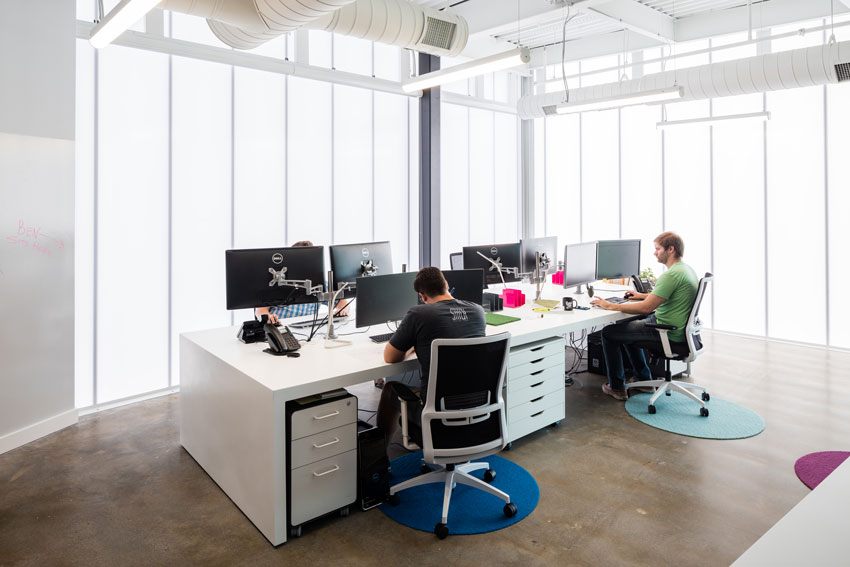
© Keith Isaacs
Project: Art for Art’s Sake Workspace
Architect: STITCH Design Shop
Smooth, even, glare-controlled daylight passing through translucent glazing provides numerous benefits to people and energy savings from reduced reliance on electric lights.
While the DOE is understandably focused on daylighting for energy-related concerns, the U.S. Green Building Council’s LEED rating system addresses it as part of Indoor Environmental Quality. In LEED v4, this EQ credit focuses on the impacts daylight has on people by stating, “Increased access to daylight has positive human behavioral and health effects because it reinforces our circadian rhythms. Access to sufficient daylight has been shown to increase healing times in hospitals, improve students’ performance, increase productivity in the workplace, fight depression and lethargy, and even increase sales in retail environments.” This is a fairly impressive list of human benefits that it backs up by citing a series of independent studies that have drawn these conclusions. In a nod toward the interrelatedness of the rating system with credits for Energy Optimization, it points out, “A well-designed daylit building also uses less electric lighting energy, conserving natural resources and reducing air pollution.” The LEED manual goes on to recommend steps to incorporate and maximize daylight while providing glare control.
In addition to daylight in general, views to the exterior are addressed with LEED v4, offering credit if at least 75 percent of the regularly occupied floor area provides views from inside a building to the outside. There are four ways that views are defined, and at least two of those four need to be achieved to receive credit, but none of them require full-height transparent glass. Rather, it is up to the designers to demonstrate how the views are achieved, with creativity and innovation being encouraged.
As part of a building design, keep in mind that daylight and views don’t necessarily need to be achieved through the same glazed wall openings. Rather, it is possible to identify separate daylight zones and view zones in a given wall. Typically, the view zone is a horizontal swath along the normal eye level range of people sitting or standing within the building. The daylighting zone can be above or below the view zone (or both). With this in mind, and the general location of people in the building defined, it is possible and desirable then to create facades that incorporate the right mix of clear-view glazing and glare-controlled daylighting glazing without a view. The design process may require several iterations to arrive at the best mix, but the opportunity to create unique, artistic, and even iconic facades is real.
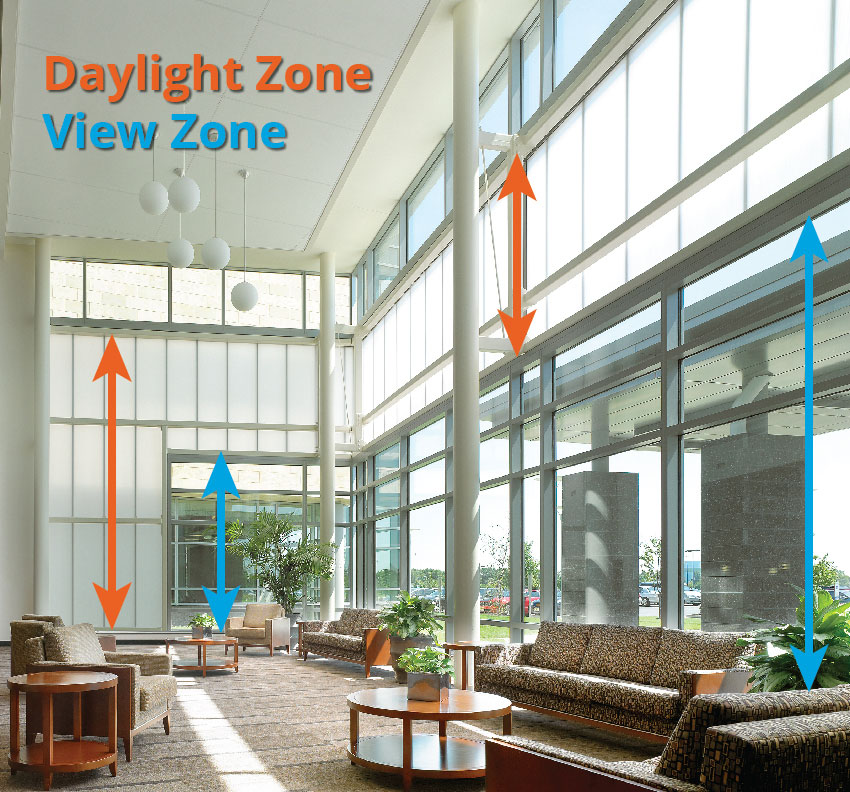
Image courtesy of CPI Daylighting
Exterior building facades can be designed to include clear-view zones that are separate from translucent daylight zones.
One of the hallmarks of a green building is the use of natural daylight to create a positive quality of lighting for indoor environments. This feature, when coupled with appropriate electric light switches or controls, also has the added benefit of being able to reduce energy costs for artificial lighting. When electric lights are turned off, they don’t generate heat, so less cooling is needed in a building. Hence, daylighting provides multiple benefits for people and buildings, but how is it best accomplished? New advances in building product technology now make it possible for architects to consider not only window openings for daylighting but the creation of entire daylit building facades. Further, understanding that clear-view glazing is not necessarily the first choice for good quality daylighting, investigation into other options using translucent glazing is warranted. Such translucent systems offer better glare control, higher thermal performance, and easier maintenance compared to clear glass systems. This course will explore some of these systems and the ways that they can contribute to innovatively designed, high-performing buildings that are fully code compliant, green, and sustainable.

© RMA Photography Inc.
Project: Element LA
Location: Los Angeles
Architect: Gensler
High-performance daylighting facades are possible using advanced systems that combine glare-controlled translucent light with customizable, thermally efficient, two-panel polycarbonate systems and nighttime facade illumination, as shown here.
Daylighting Evolution
Incorporating natural light into buildings has been part of design and construction since primitive times and has continued throughout all historical time eras in all parts of the world. So why is it seen as something new or different today? Because our building envelopes are different than in historical times.
We no longer rely solely on the heavy mass of cave dwellings or masonry buildings to separate the indoors from the outdoors. Rather, we more commonly use lighter-weight structural systems that are clad with lightweight building envelopes that need to provide a series of functions, only one of which is to allow natural daylight. And, just as importantly, that daylight needs to be controlled so that it is useful, without creating glare or other unwanted outcomes for occupants. At the same time, 21st century building enclosures need to meet significant standards for energy conservation in buildings, whether for minimum energy code compliance or to achieve high performance as demonstrated through voluntary certification programs such as LEED.
A frequently referenced resource, particularly for government or institutional buildings, is the Whole Building Design Guide. It discusses and defines daylighting for buildings of our era this way: “Daylighting is the controlled admission of natural light, direct sunlight, and diffused skylight into a building to reduce electric lighting and saving energy.” It is noteworthy that it distinguishes natural light from direct sunlight and from diffused skylight. Each of these are indicative of different types of light quality. Regarding the benefits of daylighting, it cites: “By providing a direct link to the dynamic and perpetually evolving patterns of outdoor illumination, daylighting helps create a visually stimulating and productive environment for building occupants while reducing as much as one-third of total building energy costs.” This speaks to both human benefits for individuals who occupy the building and to the successful operation of the building itself as energy efficient and economical to operate.
The United States Department of Energy (DOE) builds on this definition and provides some practical guidance for the design of buildings that seek to use daylighting. They start by taking into account the different compass orientations of sunlight striking a building throughout the year. The DOE first points out that “south-facing windows allow most winter sunlight into buildings but little direct sun during the summer, especially when properly shaded.” This statement reflects the changing position of the sun relative to the horizon (i.e., sun altitude) as the earth cycles between summer and winter seasons. Low sun angles in winter have the ability to penetrate deeper into a building than the higher angles in the summer. That can be good at spreading daylight throughout a space and may also help with some welcome solar warmth during cold weather. The reference to shading the southern facade is indicative of common practices used to shield windows from summer sun in order to avoid unwanted solar heat gain in the building triggering more use of air-conditioning. That same shading will necessarily restrict the daylight too.
Moving on to other compass orientations, the DOE advises, “East- and west-facing windows provide good daylight penetration in the morning and evening, respectively, but may cause glare, admit a lot of heat during the summer when it is usually not wanted, and contribute little to solar heating during the winter.” These orientations seem to have very little benefit and several challenges, particularly when clear glazing is used. Finally, it points out, “North-facing windows admit relatively even, natural light, producing little glare and almost no unwanted summer heat gain.” Here, the reliance is on sunlight that is reflected from surroundings or is simply ambient in nature, providing even illumination. This is the even, diffuse lighting often sought after in artist’s studios or workplaces with many computer monitors. While it produces no solar heat gain in the summer, neither does it do so in the winter, although for most commercial and institutional buildings, heating is not the primary energy use—air-conditioning often is.

© Keith Isaacs
Project: Art for Art’s Sake Workspace
Architect: STITCH Design Shop
Smooth, even, glare-controlled daylight passing through translucent glazing provides numerous benefits to people and energy savings from reduced reliance on electric lights.
While the DOE is understandably focused on daylighting for energy-related concerns, the U.S. Green Building Council’s LEED rating system addresses it as part of Indoor Environmental Quality. In LEED v4, this EQ credit focuses on the impacts daylight has on people by stating, “Increased access to daylight has positive human behavioral and health effects because it reinforces our circadian rhythms. Access to sufficient daylight has been shown to increase healing times in hospitals, improve students’ performance, increase productivity in the workplace, fight depression and lethargy, and even increase sales in retail environments.” This is a fairly impressive list of human benefits that it backs up by citing a series of independent studies that have drawn these conclusions. In a nod toward the interrelatedness of the rating system with credits for Energy Optimization, it points out, “A well-designed daylit building also uses less electric lighting energy, conserving natural resources and reducing air pollution.” The LEED manual goes on to recommend steps to incorporate and maximize daylight while providing glare control.
In addition to daylight in general, views to the exterior are addressed with LEED v4, offering credit if at least 75 percent of the regularly occupied floor area provides views from inside a building to the outside. There are four ways that views are defined, and at least two of those four need to be achieved to receive credit, but none of them require full-height transparent glass. Rather, it is up to the designers to demonstrate how the views are achieved, with creativity and innovation being encouraged.
As part of a building design, keep in mind that daylight and views don’t necessarily need to be achieved through the same glazed wall openings. Rather, it is possible to identify separate daylight zones and view zones in a given wall. Typically, the view zone is a horizontal swath along the normal eye level range of people sitting or standing within the building. The daylighting zone can be above or below the view zone (or both). With this in mind, and the general location of people in the building defined, it is possible and desirable then to create facades that incorporate the right mix of clear-view glazing and glare-controlled daylighting glazing without a view. The design process may require several iterations to arrive at the best mix, but the opportunity to create unique, artistic, and even iconic facades is real.

Image courtesy of CPI Daylighting
Exterior building facades can be designed to include clear-view zones that are separate from translucent daylight zones.
Daylighting Options in Facades
When it comes to incorporating daylighting into building facades, the discussion necessarily needs to focus on materials and systems that can do that. There are two fundamental types of material-based systems discussed as follows.
Glass-Based Systems
Glass is a well-known material that is used pervasively in buildings. Typically, it is incorporated into manufactured products that use wood, aluminum, or other materials to support, encircle, and frame one or more panes of glass. The glass itself can be clear, translucent, or opaque depending on the needs of the building design and the type of light and view qualities being sought. When the glass is clear, then glare control becomes an important design consideration. Translucent glass or glass treated with coatings, tints, or frits can address glare, but to varying degrees. Variations on sheet glass include glass block or thick channel glass sections (i.e., long U-shaped sections) that are primarily translucent in nature.
Depending on the building type and design, glass-based products typically become part of the facade in one of three ways. The first is to use sized openings in insulated walls to receive a manufactured window unit of a specified type and size. This is most common in residential and light commercial buildings and was the norm for most buildings prior to the 20th century. The second typical system is a storefront glazing system, getting its name from its most common use: retail display windows. This is typically a field-assembled set of aluminum frames that receive full-height panes of glass to maximize view (in this case, typically into the store rather than out) and provide an economical facade. Storefront systems are intended to fall within a building structure and are considered best for first- and second-floor exterior applications or interior installations. A combination of these first two approaches is sometimes called a “window wall” where a large structural opening is filled in with multiple window units. The third approach to daylighting with glass is to use a curtain wall system. These systems can be field assembled or factory fabricated into “unitized” sections that are custom made to fit on the outside of a building structure. In so doing, the glazed sections are supported on the exterior side of floors, columns, beams, etc. creating a continuous facade appearance. Places where vision glass is not needed or desirable are filled in with opaque spandrel panels or can use translucent glass. While all of these glass-based systems are well-known, they can also be one of the more costly parts of a building facade. They also bring considerations of weight and the possibility of breakage.
Nonglass-Based Systems
The limitations of glass have prompted a number of glazing systems to be developed as viable and attractive alternatives. Fiberglass-reinforced panels (FRPs) are one type of glazing that has been commonly used for industrial or institutional settings. These panels are lighter weight than glass but have some inherent structural limitations typically requiring an internal grid of supports between two layers of FRP sheet. They are commonly translucent, offering diffuse light, but over time, the FRP glazing has been known to discolor affecting both appearance and light quality. There is also the option of placing translucent insulation between the two layers with improved thermal performance, albeit less light transmittance.
Another alternative glazing material is found in high-quality polycarbonate. This material was first used in single-panel products that were extruded into a single panel with large, (approximately 1½ inches) wide internal cells. This produced a single polycarbonate panel that some manufacturers described as “double glazed” since the inner and outer surfaces were separated by the internal cells. Most use tongue-and-groove methods to connect adjacent panels or set them in aluminum frames like storefront systems. While these worked well in some locations, many did not meet the performance requirements of evolving codes and rating systems or the expectations of some design professionals.
Fortunately, the development of polycarbonate products did not stop there. Newer products include extruded polycarbonate glazing panels with smaller, tighter cells (on the order of 18 hundredths of an inch) that provide superior light diffusion and material durability. They still have an inner and outer face separated by the inner cells, but because these glazing panels are comparatively thinner than their predecessors, they are often used in systems that place two polycarbonate panels into one unitized panel assembly. Compared to insulated glass, this type of “two-panel system” (referring to the two polycarbonate panels in the assembly) increases the thermal performance, reduces the weight of the glazing, and eliminates the breakage concern—all at less cost than glass.
There is a third type of alternative glazing, namely acrylic products. However, this is usually found in bubble style unit skylights rather than in building facades. It also carries some notable limitations due to fire code compliance (i.e., flammability), durability, span length, and discoloration.
High-Performing Translucent Daylighting Systems
All of the information just covered should make it clear that there are multiple options available and certain considerations to take into account when designing a daylighting system into a building. It is important to recognize, however, that all of the components need to be selected to work together as a system to create a high-performing facade that can produce both advanced daylighting and good thermal control. By understanding some of the advances in alternative glazing systems, a great daylighting design can be accomplished while still meeting high-performance goals for energy efficiency.
Perhaps the best example of these advances is found in currently available manufactured two-panel products using tight-cell polycarbonate glazing. These products incorporate two independent polycarbonate panels that are spaced apart with internal aluminum support members. This two-panel, translucent system provides architects with a unitized, integrated daylighting solution that can be readily worked into many different building types. As such, it is extremely versatile in that it can be used in configurations based on window, storefront, or curtain wall type of assemblies to suit different building structures or project conditions. We will take a closer look at these systems in the following sections.
Design Attributes
Translucent daylighting panel systems have sometimes been thought of as only a utility product. However, the latest high-performance, tight-cell, two-panel polycarbonate systems have become a feature that architects can use as a signature aspect of virtually any building exterior design. Perhaps the most striking example of the successful use of a two-panel system is the creation not just of daylit openings as part of a wall (i.e., punched window appearance), but rather, of an entire wall that becomes a fully daylit facade (i.e., luminous walls). The glare-reducing aspect of the translucent glazing provides a continuous facade with consistent diffuse light along the entire wall. This diffuse light creates the preferred light quality in most commercial and institutional building settings comparable to the desirable northern sunlight mentioned earlier. An important point to recognize is that this lighting quality is achieved not by introducing more daylight, but less. Too much light creates the stark contrasts that cause glare. Controlled diffuse light provides even illumination, thus eliminating glare and allowing for ideal lighting conditions. Therefore, more daylight is not necessarily better light—in fact, it may be worse.

© Derek Lepper
Project: Richmond Olympic Oval
Location: Vancouver, British Columbia, Canada
Architect: Cannon Design
Translucent glazing systems allow natural light to penetrate during the day but transform buildings at night by allowing internal electric lighting to illuminate the facade from within.
As an added design attribute, using translucent glazing allows the building to be transformed at night when the light source changes from the outside (the sun) to the inside of the building (electric lights). In this case, the same glazing now allows the building to take on a stunning glowing effect that gives the building a truly transformative quality. These facades can even be used at night to illuminate exterior spaces next to the building, reducing the need for additional exterior light fixtures and providing a more consistent exterior light quality too.
Looking more closely at the panel design, there are several aspects that can be used as an advantage to the appearance of the building. The first is the uniform, clean, and smooth appearance that can be achieved. Systems that employ concealed support members with glazing that covers and hides the aluminum only display the continuous glazing on the exterior. Hence, the resulting minimal vertical seams between panels give them the aesthetic quality of channel glass panels but with less weight and less cost. Horizontal seams can be reduced or eliminated as well since the internal supports and a unitized panel design can allow for full height spans. In these cases, the panels can be custom manufactured in lengths up to 40 feet and installed outside of the structure, just the way curtain wall systems are installed. Their lighter weight and internal structural strength make them easier to handle and less expensive than their glass-based counterparts.
The color of the glazing panels is another way to influence both the exterior and interior appearance of the building. Clear polycarbonate with small, tight cells will diffuse light effectively, but some prefer a white color that can diffuse the light and appearance even more. Other standard colors such as greens, blues, or bronze are also available that can enhance the light quality or be used only in selected panels to create a particular pattern or reinforce an identity for a building. Custom colors and color matching are also available from some manufacturers. Unique to the two-panel system is the ability to have different colors on the exterior and interior of the facade. This bicolor capability can create a desired appearance on the outside while allowing for a rather different one on the inside. It is also possible to add patterns or graphics over or within the glazing panels to fully customize a look. Whatever the final design configuration, high-quality two-panel systems can be selected that will not only look good when first installed but have been shown to retain their appearance and coloring over time.
Performance Attributes
From a performance perspective, different options in two-panel translucent systems can achieve different levels of daylighting and energy efficiency. These levels are based on the standard designations and testing protocols used for other glazing systems, including the industry standard National Fenestration Rating Council (NFRC). As such, any glazing materials or products being considered should be evaluated using this data, which is based on independent testing and certification by the NFRC. Such data and reports are available both from the manufacturer and the NFRC website (www.nfrc.org).
Using the NFRC test standards, both the glazing itself and the system (glazing panel and frame) can be tested with the appropriate values determined. The standard configuration is to provide an inner and outer layer of tight cell polycarbonate glazing, each approximately 10 millimeters (just over 3/8 inch) separated by approximately 3 or 4 inches of air in between. Looking first at thermal performance, the insulating nature of the glazing compared to the conductive nature of glass yields good results. Tested values for the center of a standard two-panel glazing configuration yield a U-factor on the order of 0.23 (R-4.35), which is notably better than most double pane glass. NFRC also tests for the entire assembly, not just the glazing, so when the tested values for the complete system (panel and frame) are looked at, they are still fairly impressive, ranging from 0.28–0.26 U-factors (R-3.57 to R-3.85) depending on the size of the panel. To improve on these values even more, manufacturers offer various types of translucent insulation that can be placed between the glazing, resulting in glazing only U-factors ranging from 0.13 to 0.07 (R-7.7 to R-14.3). Testing the whole assembly yields results ranging from U-0.17 to U-0.09 (R-5.88 to R-11.11). These levels put the translucent insulated panels on par with values for some opaque, insulated walls.
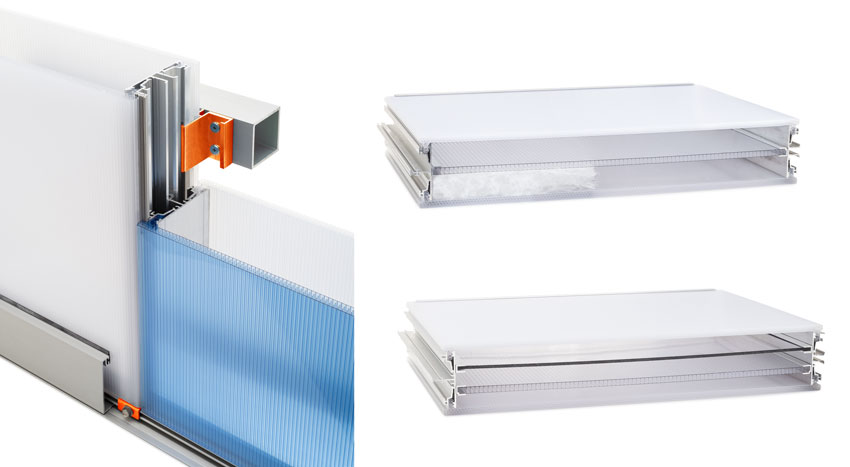
Images courtesy of CPI Daylighting
Two-panel polycarbonate systems with an internal aluminum support frame can be glazed on the interior and exterior with different colored glazing that provides different performance characteristics. Translucent insulation can be added in the space between glazings for greater thermal performance as well.
NFRC also tests glazing and panel units for other important factors, such as visible light transmittance (VT) and solar heat gain coefficient (SHGC). These numbers are directly influenced by choices in the color and reflectiveness of the polycarbonate glazing since different ones are available. Two layers of clear glazing, for example, can yield values (for the glazing only) of 42 percent VT and 0.44 SHGC—all very favorable compared to glass. For projects where less light is desired to further control glare or reduce heat gain, different combinations of color and reflectiveness can be specified for the interior and exterior glazing. Depending on the choices made, VT can range from 13 to 30 percent and SHGC can range from 0.25 to 0.37. Both values can be reduced a bit further when translucent insulation is added. Understanding these values, colors can be customized to fit the performance needs of a particular project.
Specialized Performance Options
In addition to the basic configurations of colored or insulated panels described above, there are also some other choices available that allow translucent panel systems to meet additional performance needs. For example, some of the techniques for insulation and tight construction that help with thermal performance also contribute to favorable acoustical control. Therefore, it is possible to ask for sound transmission class (STC) ratings on manufactured panels to help in buildings where noise is a concern. Similarly, facilities that have high security needs, such as military or government buildings, usually require a means to resist forced entry, and two-panel systems can be selected to satisfy this need.

Images courtesy of CPI Daylighting
An option for enhanced light control is the use of adjustable louvers that can be placed between the two layers of glazing.
One of the more advanced options for double-layered panels is the use of movable louvers located between the glazing layers. Selecting such a louvered system eliminates the need for exterior or interior shades or louvers but also allows for greater daylighting control. Referred to as “dynamic daylighting,” the louvers can manually or automatically adjust to control the amount of daylighting in several ways. First, as the sun moves throughout the day, the louvers can move to help reflect and direct light to where it is most wanted inside or deflect it to eliminate bright spots. Alternatively, the louvers can be set in a random or defined pattern to help further distribute and diffuse the sunlight. This can be particularly helpful on south-facing facades that receive a lot of direct sunlight. Finally, they can be used to shade or darken the space for times when the daylight is not needed, say for presentations or other activities. The specifics of how such a dynamic shading system work will be dependent on the specific system, so manufacturers should be consulted for details.
Operation and Maintenance Attributes
Most glazing systems need some type of maintenance, at least for routine cleaning. Occasionally, they also need attention due to wear or damage. In conventional glass systems and some other alternative systems, that usually means that part or all of the entire facade system may need to be removed, repaired, or replaced. By contrast, one of the features of the more advanced two-panel translucent systems is that they use a removable skin technology approach. This provides the flexibility to replace individual panels rather than the entire system. This can be particularly useful in cases where vandalism or severe conditions are anticipated to be an operations issue. Extra glazing panels can be stored at the facility and be readily used to replace damaged glazing whenever needed. Hence, each panel can be removed independently without removal of the entire system, allowing building operations to remain uninterrupted and without compromising the integrity of the building envelope. Removable skin technology also means that if there is a future need for updating the exterior, those panels can be changed without interrupting ongoing building operations.
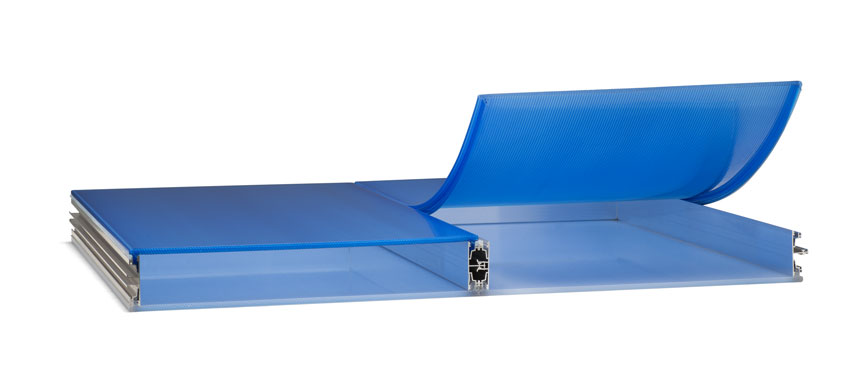
Images courtesy of CPI Daylighting
Removable skin technology allows one of the polycarbonate glazing layers to be removed from the panel without impacting the other layer or the aluminum internal structure. Hence, repairs can be made without interrupting building operations.
Part of the reason the removable skin approach works is that it is based on a positive “dry” attachment of the glazing using gaskets that does not rely on sealants or adhesives. Rather, the glazing itself is formulated to be installed and locked into place in the aluminum support members of the unitized panel. This allows the free expansion and contraction of the glazing and aluminum components without compromising the panel joint. It also avoids possible delamination of the polycarbonate glazing from the internal support members.
Codes, Standards, and Translucent Glazing
Polycarbonate is an architectural-grade plastic material that is extremely durable, impact resistant, and shatterproof. Further, the internal aluminum supports provides spanning and deflection control capabilities based on the aluminum member sizing (i.e., approximately 3 or 4 inches deep). This combination of material strength and durability allows it to meet a full range of requirements in different codes and standards, including the deflection limitations of the International Building Code (IBC Table 1604.3), which call for a maximum deflection of L/120. Further, the two-panel system design helps to keep the building envelope sealed without any compromise on its integrity. That is because the interior panel is protected from exterior weather conditions, UV radiation, impact, and other hazards, and can remain fully intact for the life of the building.
For energy codes and standards, we have discussed how U-factor requirements can be achieved to meet minimum thermal performance as required in the IECC and verified by the NFRC. They can also be demonstrated to meet the requirements of the California Energy Code (Title 24). Moving from sustainability to resilience, these systems have been tested and shown to pass all requirements for Florida Product Approval and impact testing for High-Velocity Hurricane Zones (HVHZ). Similar certifications are available for the Texas Department of Insurance (TDI) wind programs. High-performance polycarbonate systems have also been tested to meet ASTM testing standards for smoke and fire requirements.
At the federal level, two-panel polycarbonate systems can also be used in applications that require Forced-Entry Protection or Anti-Terrorism Force Protection (ATFP). In locations that require it, they also can meet Occupational Safety and Health Administration (OSHA) requirements for fall through protection if used in skylights.
Note that it is important to keep in mind that there are different grades and qualities of polycarbonate and that not all will pass all tests or meet all needed standards. Therefore, consultation with manufacturers’ representatives and third-party product certification directories may be needed to verify which products are suitable for a given project.
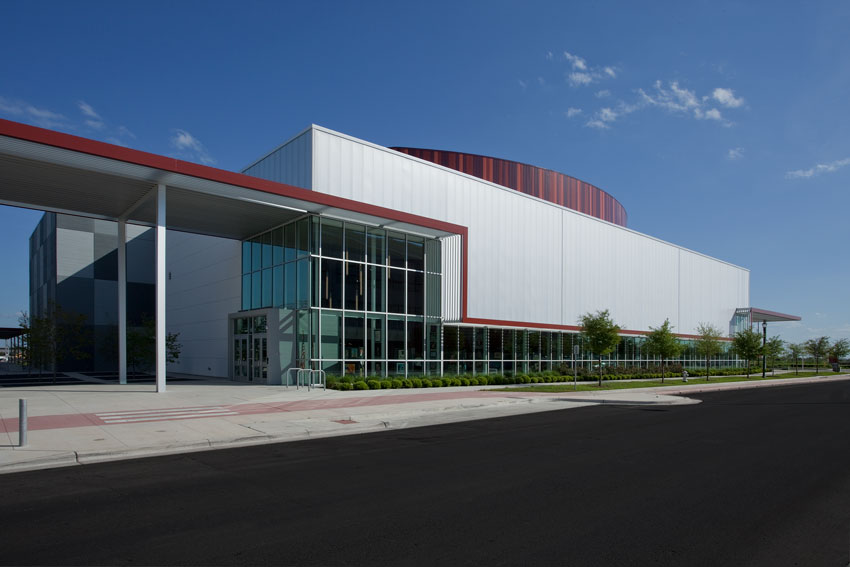
© Bill Lemke
Project: ISD Performing Arts Center
Translucent two-panel polycarbonate building facades can be created with manufactured products that meet the requirements for building codes, energy codes, and voluntary standards such as LEED.
Green Building Contributions of Translucent Facades
We have discussed throughout this article numerous ways that two-panel translucent systems can contribute to green building design and construction. By way of tying those altogether, here is a quick summary based on the relevant categories in LEED:
-
Energy and Atmosphere: As a primary part of the building facade, a full energy-performance model can be developed based on using the appropriate NFRC ratings for U-factor, solar heat gain coefficient, visible transmittance, and air leakage if available. Further, the coordination between using natural daylight and electrical lighting should be incorporated as part of the computer model for total energy performance.
- Materials and Resources: PPolycarbonate panels and the aluminum components can contain significant recycled content. Further, panels can be salvaged and reused in other buildings or recycled at the end of their service life. All of these attributes help to reduce their environmental impact as shown in a life-cycle assessment (LCA) or environmental product declaration (EPD).
- Indoor Environmental Quality: The addition of daylight is clearly the strongest contributor to this credit category, but by combining translucent and clear glazing, the facade can also provide appropriate views as well. Further, for systems that avoid sealants and adhesives, requirements for low-VOC-emitting materials can be met. This is carried through in the prefinished nature of the panels since no paints, coatings, adhesives, or sealants needed.
As part of an overall building design, then, high-performance translucent facade systems can be a significant part of achieving LEED certification or similar recognition.
Specifying Translucent Wall Systems
Specifications for translucent wall panel systems must be tailored to project needs but also with a clear understanding that not all systems are the same. Therefore, architects writing specifications for these systems need to be select from the appropriate differences and specific capabilities of the available manufactured products, thus making good spec writing critically important. Under the Master Format specification standard, these systems are normally found in Section 08.45.00 or related sections.
Under Part 1: General, in a standard three-part specification, the required performance standards should be listed for the products and system as a whole, including the NFRC100 and NFRC 400 testing standards for the thermal and light aspects of the system. Further, relevant ASTM standards for glare or “haze” (ASTM D1003) should be cited. For other code concerns, specify the needed ASTM standards for Self-Ignition Temperature (ASTM 1929-3), Smoke Density (ASTM D-2843), Burning Extent (ASTM D-635), and Interior Flame Spread (ASTM D-84). It may also be appropriate to cite ICC evaluation service report for compliance with IBC building code for polycarbonate glazing as an approved light transmission plastic with a CC1 rating per chapter 26, and class A interior finish glazing per chapter 8. Other standards can be cited for conditions relevant to the project, such as weathering, load-bearing capability, resilience, security, and sound transmission.
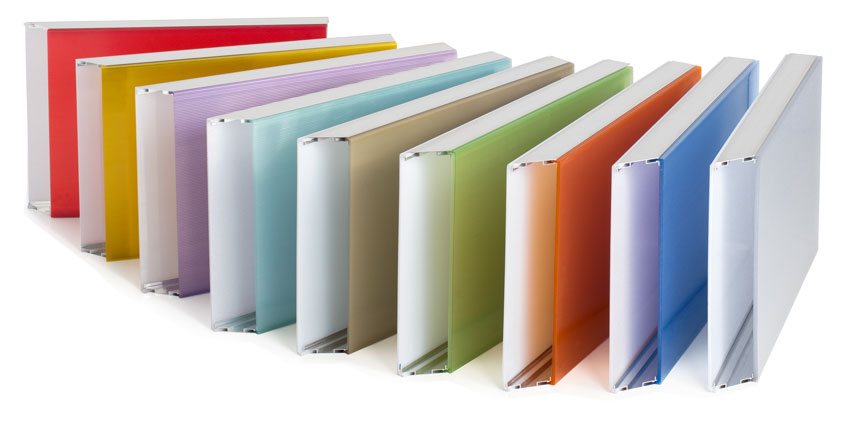
Image courtesy of CPI Daylighting
When specifying tight-celled polycarbonate glazing systems, it is important to select the color combinations for each location in the building.
Under Part 2: Products, there should be reference to a glazing schedule or other information on the drawings if multiple versions of glazed panels are being used so the locations in the building are clear. The specification should then go on to provide the details of each of the scheduled or identified glazing and frame products. All of the color selections and performance criteria of both the polycarbonate glazing and the metal materials should be identified and specified. Ideally, all materials should be specified to come from a single manufacturer as an integrated, coordinated, all-in-one glazing product.
In Part 3: Installation requirements, attention should be given to a preinstallation conference or meeting once the building structure is in place. This assures the opportunity for coordination between the general contractor and the trades involved in the proper installation of the translucent facade system. If possible, certified or trained installers of the system should be called for. Final placing, protecting, and cleaning in a manner consistent with manufacturer’s recommendations and standards will round out the specification.
Conclusion
Daylighting provides significant benefits to people and buildings. New and improved products and materials that address the latest concepts in good daylighting design provide architects with exciting new design opportunities. In particular, high-performance two-panel polycarbonate systems can combine the best of translucent daylighting with clear-view glazing. As a complete, coordinated system, the end result can be a striking building facade that meets both the design and performance requirements for buildings of all types.
Peter J. Arsenault, FAIA, NCARB, LEED AP, is a practicing architect, green building consultant, continuing education presenter, and prolific author engaged nationwide in advancing building performance through better design. www.linkedin.com/in/pjaarch

|
CPI Daylighting, a Kingspan Light + Air company, is an award-winning innovator of translucent daylighting technology for high-performance building envelopes, specializing in walls, skylights, and canopies. As a pioneer and leader of the industry, we are committed to advancing daylighting design and inspiring architects to push the envelope. www.cpidaylighting.com
|










